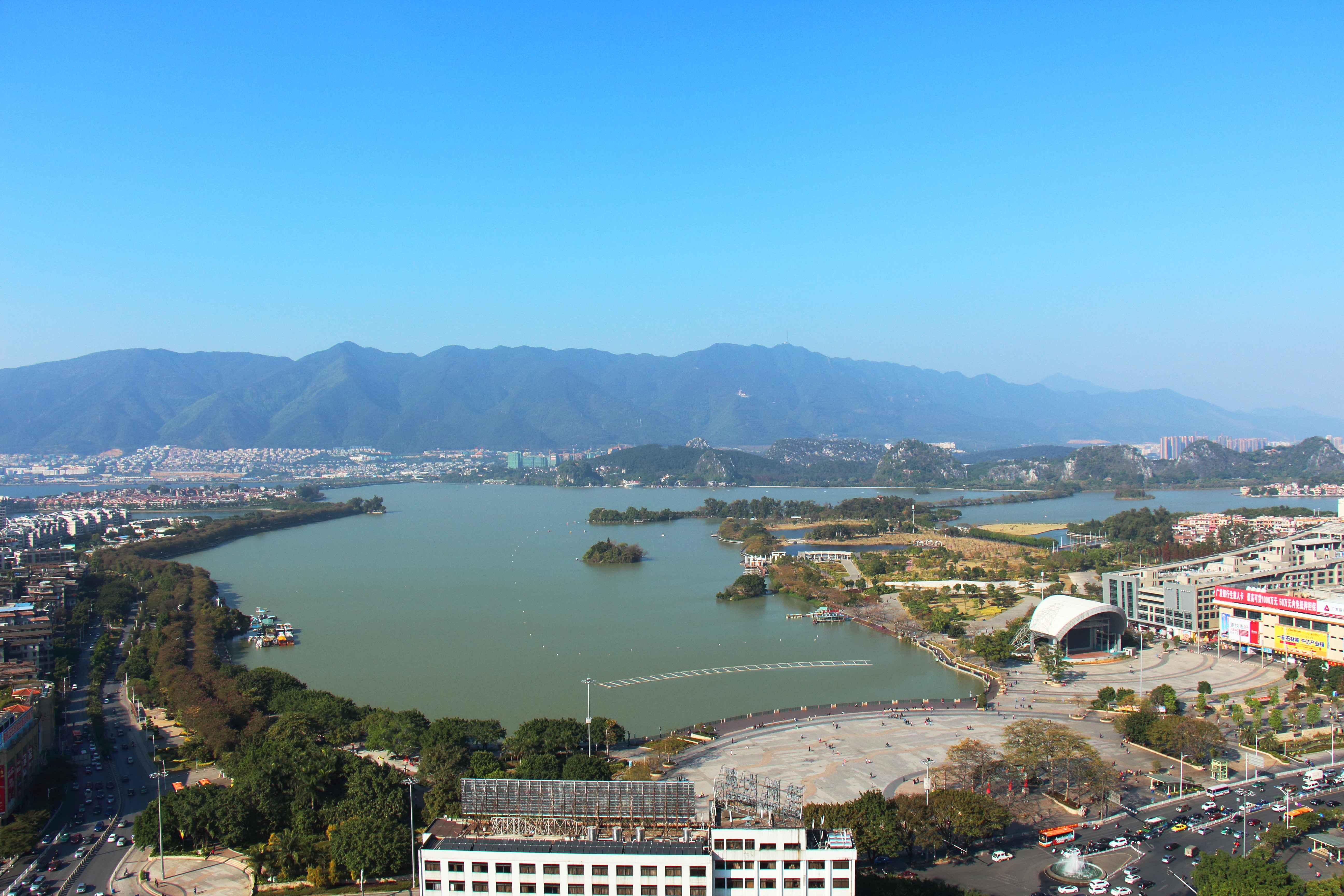|
Xijiang
The Xi River (; ) or Si-Kiang is the western tributary of the Pearl River in southern China. It is formed by the confluence of the Gui and Xun Rivers in Wuzhou, Guangxi. It originates from the eastern foot of the Maxiong Mountain in Qujing City, Yunnan Province. Then it flows east through Guangdong, and enters the Pearl River Delta just east of the Lingyang Gorge in Zhaoqing. The main branch of the Xi River flows southeast through the delta entering the South China Sea at Modao Men, just west of Macau. The major cities along the Xi include Wuzhou, Zhaoqing, and Jiangmen. The other two main tributaries of Pearl River are the Dong River (literally, the East River) and Bei River (the Northern River). Other transliterations of the river's name include Hsi River and Hsi Chiang. As for other functions, it plays a vital role in carbon storage and transport in Southern China. The Xi River is facing some ecological challenges such as drought, invasive species, and pollution. ... [...More Info...] [...Related Items...] OR: [Wikipedia] [Google] [Baidu] |
Bei River
Bei River (北江; literally "The North River"; pinyin: ''Běi Jiāng''; wade-giles: ''Pei3 Chiang1''; jyutping: ''Bak1 Gong1'', literally "North River") is the northern tributary of the Pearl River in southern China. The other two main tributaries of the Pearl River are the Xi Jiang and the Dong Jiang. The Bei River is long, and is located in northern Guangdong. See also * Pearl River Delta * Geography of China * List of rivers of Asia A ''list'' is any set of items in a row. List or lists may also refer to: People * List (surname) Organizations * List College, an undergraduate division of the Jewish Theological Seminary of America * SC Germania List, German rugby union ... References Rivers of Guangdong Tributaries of the Pearl River (China) {{China-river-stub ... [...More Info...] [...Related Items...] OR: [Wikipedia] [Google] [Baidu] |
Pearl River (China)
The Pearl River, also known by its Chinese name Zhujiang or Zhu Jiang in Mandarin pinyin or Chu Kiang and formerly often known as the , is an extensive river system in southern China. The name "Pearl River" is also often used as a catch-all for the watersheds of the Xi ("West"), Bei ("North"), and Dong ("East") rivers of Guangdong. These rivers are all considered tributaries of the Pearl River because they share a common delta, the Pearl River Delta. Measured from the farthest reaches of the Xi River, the Pearl River system is China's third-longest river, after the Yangtze River and the Yellow River, and second largest by volume, after the Yangtze. The Pearl River Basin () drains the majority of Liangguang (Guangdong and Guangxi provinces), as well as parts of Yunnan, Guizhou, Hunan and Jiangxi in China; it also drains northern parts of Vietnam's Northeast Cao Bằng and Lạng Sơn provinces. As well as referring to the system as a whole, the Pearl River (Zhu Jiang) nam ... [...More Info...] [...Related Items...] OR: [Wikipedia] [Google] [Baidu] |
Jiangmen
Jiangmen (), alternately romanized in Cantonese as Kongmoon, is a prefecture-level city in Guangdong Province in southern China. As of the 2020 census, its three urban districts, plus Heshan City being conurbated, with 2,657,662 inhabitants are now part of the Guangzhou–Shenzhen conurbation with 65,565,622 inhabitants and the entire prefecture had a population of about 4,798,090 inhabitants. Names Jiangmen is the pinyin romanization of the Chinese name or , based on its pronunciation in the Mandarin dialect. Its former Wade-Giles spelling was . The Postal Map spelling "Kongmoon" was based upon the same name's Cantonese pronunciation ''Gong¹-moon⁴''. Other forms of the name include Kongmoon, Kongmun, and Kiangmoon. Jiangmen is also known as Pengjiang. Its rural hinterland is known to the Chinese diaspora as the " Four Counties" (q.v.), although the addition of Heshan to Jiangmen has prompted the remaining locals to begin calling it the "Five Counties" instead. Histo ... [...More Info...] [...Related Items...] OR: [Wikipedia] [Google] [Baidu] |
Wuzhou
Wuzhou (, postal: Wuchow; za, Ngouzcouh / Ŋouƨcouƅ), formerly Ngchow, is a prefecture-level city in the east of Guangxi Zhuang Autonomous Region, People's Republic of China. Geography and climate Wuzhou is located in eastern Guangxi bordering Guangdong province. It is at the confluence of the Gui River and the Xun River where they form the Xi River; 85% of all water in Guangxi flows through Wuzhou. The total area of Wuzhou is . The Tropic of Cancer bisects the city. Despite its latitude, Wuzhou has a monsoon-influenced humid subtropical climate (Köppen ''Cfa''), with short, mild winters, and long, very hot and humid summers. Winter begins dry but becomes progressively wetter and cloudier. Spring is generally overcast and often rainy, while summer continues to be rainy though is the sunniest time of year. Autumn is sunny and dry. The monthly 24-hour average temperature ranges from in January to in July, and the annual mean is . The annual rainfall is just above , and is ... [...More Info...] [...Related Items...] OR: [Wikipedia] [Google] [Baidu] |
Guangdong
Guangdong (, ), alternatively romanized as Canton or Kwangtung, is a coastal province in South China on the north shore of the South China Sea. The capital of the province is Guangzhou. With a population of 126.01 million (as of 2020) across a total area of about , Guangdong is the most populous province of China and the 15th-largest by area as well as the second-most populous country subdivision in the world (after Uttar Pradesh in India). Its economy is larger than that of any other province in the nation and the fifth largest sub-national economy in the world with a GDP (nominal) of 1.95 trillion USD (12.4 trillion CNY) in 2021. The Pearl River Delta Economic Zone, a Chinese megalopolis, is a core for high technology, manufacturing and foreign trade. Located in this zone are two of the four top Chinese cities and the top two Chinese prefecture-level cities by GDP; Guangzhou, the capital of the province, and Shenzhen, the first special economic zone in the count ... [...More Info...] [...Related Items...] OR: [Wikipedia] [Google] [Baidu] |
Random House Webster's Unabridged Dictionary
''Random House Webster's Unabridged Dictionary'' is a large American dictionary, first published in 1966 as ''The Random House Dictionary of the English Language: The Unabridged Edition''. Edited by Editor-in-chief Jess Stein, it contained 315,000 entries in 2256 pages, as well as 2400 illustrations. The CD-ROM version in 1994 also included 120,000 spoken pronunciations. History The Random House publishing company entered the reference book market after World War II. They acquired rights to the ''Century Dictionary'' and the ''Dictionary of American English'', both out of print. Their first dictionary was Clarence Barnhart's ''American College Dictionary'', published in 1947, and based primarily on ''The New Century Dictionary'', an abridgment of the ''Century''. In the late 1950s, it was decided to publish an expansion of the ''American College Dictionary'', which had been modestly updated with each reprinting since its publication. Under editors Jess Stein and Laurence Ur ... [...More Info...] [...Related Items...] OR: [Wikipedia] [Google] [Baidu] |
Dong River (China)
The Dong River is the eastern tributary of the Pearl River in Guangdong province, southern China. The other two main tributaries of Pearl River are Xi River and Bei River. The headwater is located in Mount Sanbai () in Anyuan County, Jiangxi. The Dong River is a major source of water for megacities in Pearl River Delta, including Hong Kong, Shenzhen, and Guangzhou. The Hong Kong Government has purchased Dong River water from Guangdong since 1965. Over 70 percent of domestic water in Hong Kong is imported from the Dong River. Its discharge totals roughly . Historical findings A dinosaur egg fossil dated back to the Late Cretaceous was discovered by primary school student named Zhang Yangzhe while playing near the Dong River in 2019 in July. The boy's mother, Li Xiaofang, later contacted the Heyuan Dinosaur Museum members, and under their excavation guidance more than 10 dinosaur egg fossils each about 9 centimeters in diameter and dating back to 66 million years were reveal ... [...More Info...] [...Related Items...] OR: [Wikipedia] [Google] [Baidu] |
Macau
Macau or Macao (; ; ; ), officially the Macao Special Administrative Region of the People's Republic of China (MSAR), is a city and special administrative region of China in the western Pearl River Delta by the South China Sea. With a population of about 680,000 and an area of , it is the most densely populated region in the world. Formerly a Portuguese colony, the territory of Portuguese Macau was first leased to Portugal as a trading post by the Ming dynasty in 1557. Portugal paid an annual rent and administered the territory under Chinese sovereignty until 1887. Portugal later gained perpetual colonial rights in the Sino-Portuguese Treaty of Peking. The colony remained under Portuguese rule until 1999, when it was transferred to China. Macau is a special administrative region of China, which maintains separate governing and economic systems from those of mainland China under the principle of " one country, two systems".. The unique blend of Portuguese and Chinese arc ... [...More Info...] [...Related Items...] OR: [Wikipedia] [Google] [Baidu] |
Zhaoqing
Zhaoqing (), alternately romanized as Shiuhing, is a prefecture-level city in Guangdong Province, China. As of the 2020 census, its population was 4,113,594, with 1,553,109 living in the built-up (or metro) area made of Duanzhou, Dinghu and Gaoyao. The prefectural seat—except the Seven Star Crags—is fairly flat, but thickly forested mountains lie just outside its limits. Numerous rice paddies and aquaculture ponds are found on the outskirts of the city. Sihui and the southern districts of the prefecture are considered part of the Pearl River Delta. Formerly one of the most important cities in southern China, Zhaoqing lost its importance during the Qing dynasty and is now primarily known for tourism and as a provincial "college town". Residents from Guangzhou, Shenzhen, and the other cities of the Pearl River Delta often visit it for weekend excursions. It is also a growing manufacturing center. Name Zhaoqing was known to the Qin and Han as Gaoyao (高要). It was re ... [...More Info...] [...Related Items...] OR: [Wikipedia] [Google] [Baidu] |
Lingyang Gorge .
{{geodis ...
Língyáng may refer to the following locations in China: * Lingyang, Qingyang County, town in southern Anhui * Lingyang, Linzhou, town in Linzhou, Henan * Lingyang, Ju County, town in Ju County, Shandong * Lingyang, Cili (零阳镇), a town of Cili County, Hunan Province Hunan (, ; ) is a landlocked province of the People's Republic of China, part of the South Central China region. Located in the middle reaches of the Yangtze watershed, it borders the province-level divisions of Hubei to the north, Jiangxi t ... [...More Info...] [...Related Items...] OR: [Wikipedia] [Google] [Baidu] |
Yunnan
Yunnan , () is a landlocked Provinces of China, province in Southwest China, the southwest of the People's Republic of China. The province spans approximately and has a population of 48.3 million (as of 2018). The capital of the province is Kunming. The province borders the Chinese provinces of Guizhou, Sichuan, autonomous regions of Guangxi, and Tibet Autonomous Region, Tibet as well as Southeast Asian countries: Vietnam, Laos, and Myanmar. Yunnan is China's fourth least developed province based on disposable income per capita in 2014. Yunnan is situated in a mountainous area, with high elevations in the northwest and low elevations in the southeast. Most of the population lives in the eastern part of the province. In the west, the altitude can vary from the mountain peaks to river valleys by as much as . Yunnan is rich in natural resources and has the largest diversity of plant life in China. Of the approximately 30,000 species of Vascular plant, higher plants in China, Yu ... [...More Info...] [...Related Items...] OR: [Wikipedia] [Google] [Baidu] |








